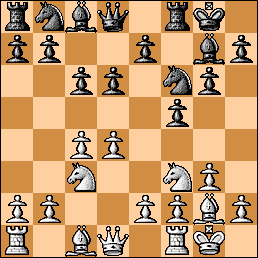7 7 5 5 3 3 Originally published 1989 | 6 6 4 4 2 2 | |
 | ||
Similar Queen's Indian Defense, Encyclopaedia of Chess Openings, The Killer Dutch, Dutch Stonewall, Modern Chess Openings | ||
The Dutch Defence is a chess opening characterised by the moves:
Contents
1. d4 f5History
Elias Stein (1748–1812), an Alsatian who settled in The Hague, recommended the defence as the best reply to 1.d4 in his 1789 book Nouvel essai sur le jeu des échecs, avec des réflexions militaires relatives à ce jeu.
Siegbert Tarrasch rejected the opening as unsound in his 1931 work The Game of Chess, arguing that White should reply with the Staunton Gambit, with White being better after 2.e4 fxe4 3.Nc3 Nf6 4.Bg5 c6 5.f3! exf3.
Theory
Black's 1... f5 stakes a serious claim to the e4 square and looks towards an attack on White's kingside in the middlegame. However, it weakens Black's own kingside somewhat, and does nothing to contribute to Black's development. The Dutch is rare in top-level play. It has never been one of the main lines against 1.d4, though in the past a number of top players, including Alexander Alekhine, Bent Larsen, Paul Morphy and Miguel Najdorf, have used it with success. Perhaps its high-water mark occurred in 1951, when both world champion Mikhail Botvinnik and his challenger, David Bronstein, played it in their World Championship match in 1951. Among the world's current top 10 players, its only consistent practitioner is Hikaru Nakamura.
White most often fianchettoes his king's bishop with g3 and Bg2. Black also sometimes fianchettoes his king's bishop with ...g6 and ...Bg7 (the Leningrad Dutch), but may instead develop his bishop to Be7, d6 (after ...d5), or b4 (the latter is most often seen if White plays c4 before castling). Play often runs 2.g3 Nf6 3.Bg2 e6 4.Nf3 (4.Nh3!? is also possible, intending Nf4–d3 to control the e5 square if Black plays the Stonewall Variation) Be7 5.0-0 0-0 6.c4 and now Black chooses between 6...d5 (the characteristic move of the Stonewall), 6...d6, the Ilyin–Zhenevsky System (less popular today), or Alekhine's move 6...Ne4!? retaining the option of moving the d-pawn either one or two squares.
The Stonewall Dutch enjoyed a resurgence of interest in the 1980s and 1990s, when leading grandmasters Artur Yusupov, Sergey Dolmatov, Nigel Short and Simen Agdestein helped develop the system where Black plays an earlier ...d5 and places his dark-squared bishop on d6. Termed the Modern Stonewall, this setup has remained more popular than the traditional early ...Be7.
The opening's attacking potential is shown in the Polish Immortal, in which Miguel Najdorf, using the Stonewall Variation, sacrificed all of his minor pieces to win by checkmate.
White continuations
The traditional move order involves White playing 2.c4. More commonly, White will start with 2.g3. Some common variations are: c4 is played after g3 and Bg2; c4 is played after Nf3; and c4 is played after 0-0.
Examples:
Other second moves
White has various more aggressive alternatives to the standard moves, including
Black sometimes starts with the move-order 1...e6 to avoid these lines although then Black must be ready to play the French Defense if White plays 2.e4 and Black can no longer play the Leningrad Dutch.
ECO
The Encyclopaedia of Chess Openings (ECO) has twenty codes for the Dutch Defence, A80 through A99.
